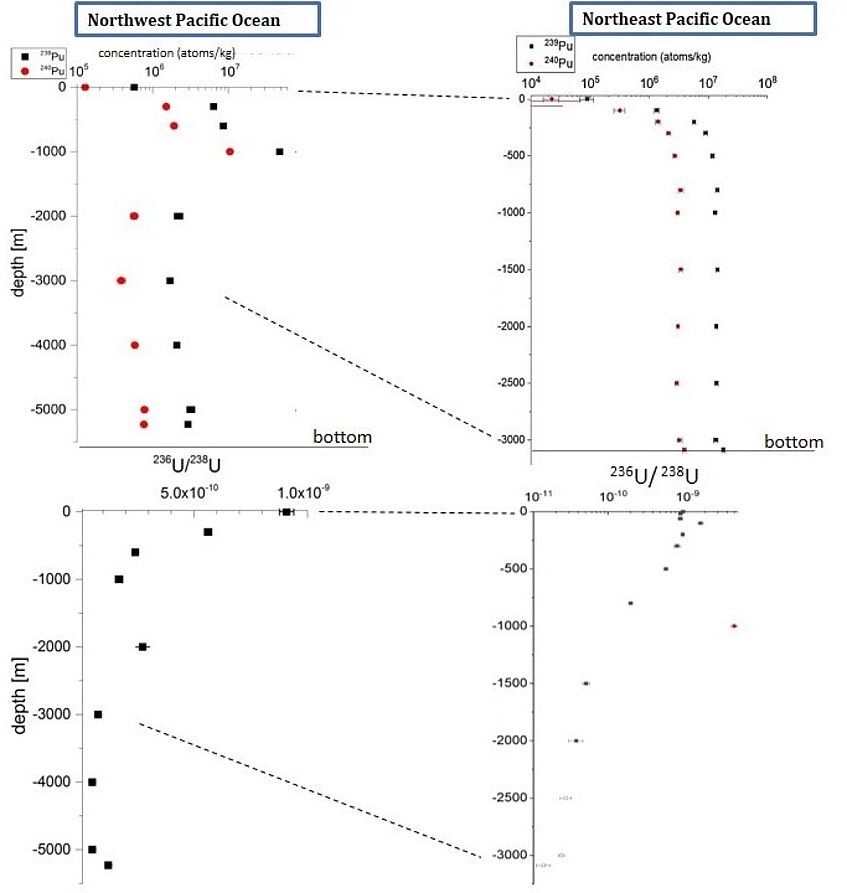(Environmental) Tracer applications
(Environmental) Tracer applications
- Anthropogenic radionuclides, including Actinides as well as fission (99Tc, 135Cs, 129I) and activation products (14C, 36Cl, 41Ca), offer unique possibilities to trace transport processes in the environment or in living beings as they are not readily abundant in the environment. Consequently, these trace nuclides are highly sensitive to minute administered doses or small recent releases into the environment allowing the observation of their propagation from the corresponding origin of emission. Major known emission sources include nuclear weapons fallout, reactor accidents and nuclear reprocessing plants. To use radionuclides as tracers, two requirements must be met:
- The corresponding element must behave conservatively in the medium which is to be labelled, i.e. it is not removed from the medium by physio-chemical processes. Consequently, the radionuclide has to be selected according to the chemical properties of the corresponding element.
- The radionuclide should be sufficiently long lived to stay detectable on the time scale of the considered transport circulations or to avoid delivering dose to the body of humans or animals.
- Sample size required for the detection of long-lived radionuclides is a crucial issue to make collection and chemical preparation of large number of samples logistically feasible and work efficiently. Thus, AMS is the technique of choice owing to its high abundance sensitivity. Some tracers used today have only become accessible at environmental concentrations through recent advances in AMS technique. For example, VERA has pioneered the detection and application of the anthropogenic isotope 236U as oceanographic tracer which is increasingly accepted in the scientific community.
- In addition, isotopic ratios like 240Pu/239Pu or 241Pu/239Pu are known to be reliable indicators for the emission source as they only depend on the production mechanism and are not affected by chemical fractionation. Source identification is essential in compartments with complex water circulation processes affected by several contamination sources or with incomplete detailed emission history, such as the Arctic Ocean. The VERA group therefore recently proposed 233U/236U as superior oceanographic tracer which was found to differ by one order of magnitude for nuclear weapons fallout and releases from nuclear power production. In the context of the Fukushima accident, there is also emerging interest in the analysis of 135Cs/137Cs, which could provide complementary information.
- Research at VERA constantly strives for expanding the range of available long-lived tracers to open up new fields of application. Apart from improving the detection efficiency for actinides, we are presently investigating their use as tracers for aerosol transport and accumulation in human lungs (in cooperation with G. Wallner, University of Vienna) and for the water balance in rain-fed peat bogs (in cooperation with S. Glatzel, University of Vienna). Our instrumental developments focus on the detection of fission products with stable isobaric background at the low environmental levels using the ILIAMS setup, i.e. 99Tc , 90Sr, 135,137Cs. With present detection limits of 90Sr (90Sr/Sr = 1.5×10−14, i.e. <0.08 mBq) and 135Cs (135Cs/Cs ≈ 2×10−12) VERA is the leading facility worldwide and first 90Sr-applications in soil samples are in preparation.

